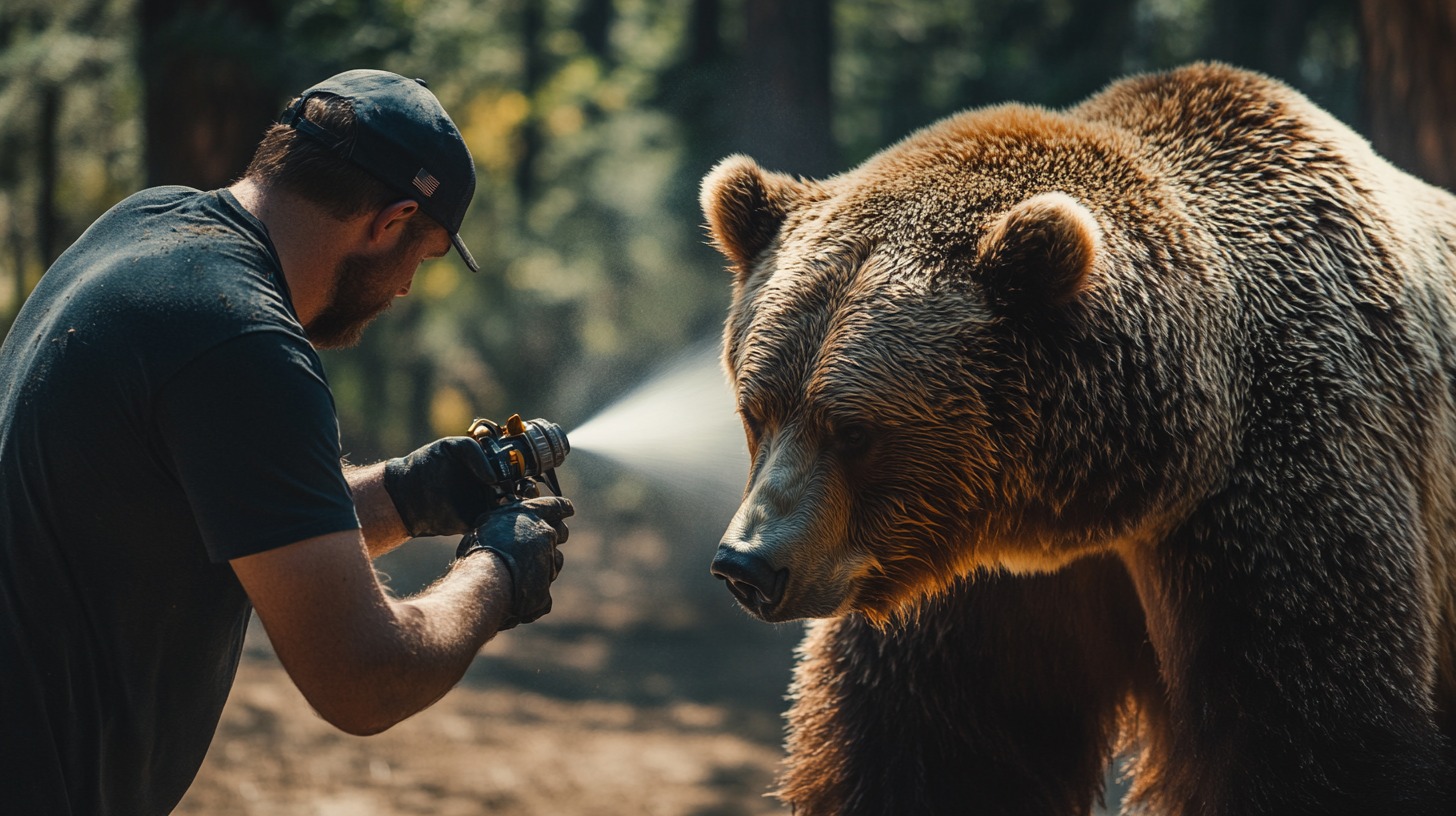Choosing the right spray for personal safety or wildlife deterrence can mean the difference between protection and vulnerability.
Bear spray and pepper spray, while often thought to be interchangeable, are designed for very different purposes and situations. By examining their composition, range, and effectiveness, it becomes clear that each has strengths suited to specific scenarios.
Knowing these differences is essential for ensuring safety in environments where threats may arise, whether in the wilderness or urban settings.
Composition and Purpose
Bear spray and pepper spray are formulated to serve distinct purposes, each tailored to address specific threats effectively.
Their differences lie in the concentration of capsaicin, intended use, and overall design, which impacts their application in various scenarios.
Bear Spray

The primary goal of bear spray is to ensure a safe retreat for both the user and the animal by creating an immediate but temporary deterrent effect.
Its design makes it a critical tool for outdoor enthusiasts venturing into bear habitats.
- Contains 1–2% capsaicin and related capsaicinoids, offering a potent formulation designed for large predators.
- Intended as a non-lethal deterrent to aggressive or charging bears.
- Creates a fog-like barrier that spreads over a wide area to maximize coverage.
- Prioritizes safety by minimizing long-term harm to both humans and wildlife.
- Specifically calibrated to respond to the size, speed, and aggressive behaviors typical of bears.
Pepper Spray

While pepper spray is highly effective in urban settings, it lacks the formulation, dispersion, and intensity required to deter larger predators like bears.
Using pepper spray in bear country would likely result in insufficient protection.
- Typically contains capsaicin concentrations between 0.18% and 3%, tailored for personal defense.
- Primarily intended to incapacitate human assailants by causing intense irritation to the eyes, nose, and skin.
- Sometimes effective against smaller aggressive animals, such as dogs.
- Dispenses in a concentrated stream to target specific threats directly.
- Designed for short-term use, providing enough time for the user to escape or seek help.
Range and Dispersion
Bear spray and pepper spray differ significantly in their range and dispersal patterns, reflecting their specific purposes and environments of use. These differences play a crucial role in determining how effectively each tool can deter potential threats.
Bear spray is crafted for outdoor scenarios involving large predators like bears. Its range extends 15 to 30 feet, offering a safe distance for the user to create a protective barrier.
The wide, fog-like dispersion covers a broad area, targeting sensitive regions like a bear’s nose and eyes to maximize effectiveness.
- Range: 15 to 30 feet.
- Dispersal pattern: Broad, cone-shaped release.
- Purpose: Creates a barrier against charging bears.
- Advantages: Covers a wide area, improving the likelihood of success.
In contrast, pepper solutions are intended for self-defense in urban or personal contexts.
With a range of 10 to 15 feet, it is suitable for targeting specific threats like human assailants or aggressive animals. Its narrow, focused dispersion ensures precision, making it effective at incapacitating targets at close range.
- Range: 10 to 15 feet.
- Dispersal pattern: Narrow and concentrated for targeted use.
- Purpose: Effective for deterring human threats and smaller animals.
- Advantages: Precise and ideal for close encounters.
The broader coverage of bear deterrents makes them indispensable in wilderness situations, while the targeted accuracy of personal defense solutions is better suited for urban safety.
Regulations and Legal Considerations
Bear spray and pepper spray operate under distinct legal frameworks, reflecting their differing purposes and applications. Users must be aware of these regulations to ensure lawful possession and proper usage.
Bear spray is widely permitted for outdoor enthusiasts who may encounter wildlife in bear-prone areas. Its use is typically unrestricted in national parks, wilderness areas, and regions with significant bear populations.
- Some areas may require buyers to show proof of intent to use it for outdoor activities.
- Certain airlines or transport companies may prohibit carrying bear spray due to its aerosolized nature.
- Local laws might restrict deployment in non-wilderness areas, even for self-defense against bears.
Users venturing into bear habitats are advised to check regional guidelines and ensure compliance with all relevant rules. Failing to adhere to these regulations could lead to fines or other legal consequences.
Pepper spray regulations, on the other hand, vary more significantly by region and may be stricter in urban settings.
- Some jurisdictions restrict capsaicin concentration to a specific range for civilian use.
- Certain states or countries may require individuals to obtain permits for possession.
- Pepper spray may only be authorized for self-defense against humans, with restrictions on its use against animals.
- Some areas mandate a minimum age for purchase or possession.
Additionally, in places with stricter regulations, pepper spray may be entirely prohibited for civilians or limited to use by law enforcement and security professionals.
- Each region may have its guidelines regarding the sale, possession, and use of pepper or bear.
- When traveling with either type of spray, understand transport restrictions to avoid confiscation.
- Bear spray is for wildlife deterrence, while pepper spray is for personal defense against humans and, in some cases, dogs.
Effectiveness in Deterrence

Bear deterrent products have proven to be highly reliable in preventing aggressive bear behavior, with studies showing a 92% success rate.
- Ensures both humans and bears can retreat safely without injury or further conflict.
- The product irritates the bear’s eyes and nose, causing discomfort severe enough to halt an attack.
- Its fog-like pattern provides a wide barrier, increasing the likelihood of effectiveness even in high-pressure situations.
These features make bear-specific deterrents an essential safety measure for anyone venturing into bear habitats, providing a reliable line of defense.
Limitations of Personal Defense Sprays
While personal defense products are suitable for protecting against human assailants or smaller animals, they fall short when used against large predators.
- Personal protection tools typically have a lower concentration, making them ineffective in stopping large, aggressive animals.
- A focused discharge requires precise aim, which can be challenging in fast-moving, high-stress encounters.
- With an effective distance of only 10 to 15 feet, these products do not offer the safe distance necessary to avoid danger during a bear encounter.
Using general-purpose deterrents against large predators risks leaving the user vulnerable to harm, emphasizing the importance of selecting the right tool for the situation.
Usage Guidelines and Safety
Proper use of bear spray and pepper spray is essential for ensuring safety in different environments. Bear spray is recommended for hikers and campers in areas where bear encounters are possible. Users should practice deploying the spray before heading into bear habitats, ensuring they can operate it quickly and effectively during a high-pressure situation.
Knowing how to aim at a bear’s face from a safe distance is crucial for maximizing the spray’s effectiveness.
Pepper spray, on the other hand, is designed for personal defense in urban settings. Users should familiarize themselves with its operation, such as unlocking the safety mechanism and aiming accurately at an assailant’s face. Additionally, individuals should be aware of the legal implications of using pepper spray, as misuse can lead to legal consequences.
Safety training and proper handling techniques are vital for both sprays. Responsible usage not only ensures personal safety but also prevents unnecessary harm to others, including wildlife.
The Bottom Line
Bear spray and pepper spray serve distinct purposes, making it important to select the appropriate option based on the environment and potential threats.
By understanding their composition, range, regulations, and usage guidelines, individuals can ensure they are prepared to handle situations effectively and responsibly.







